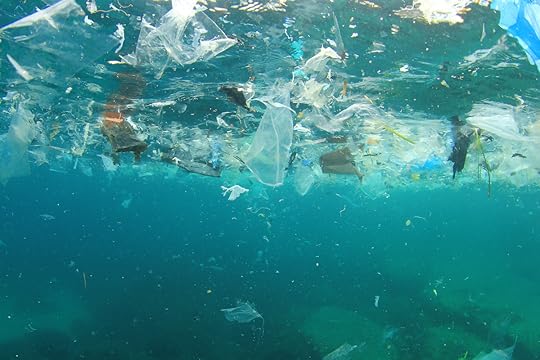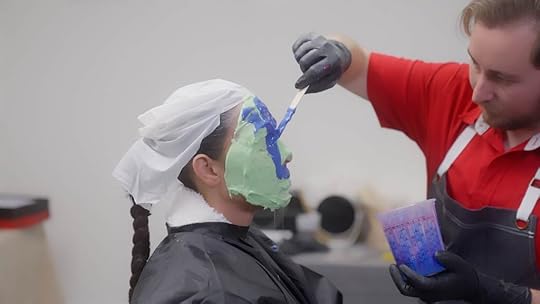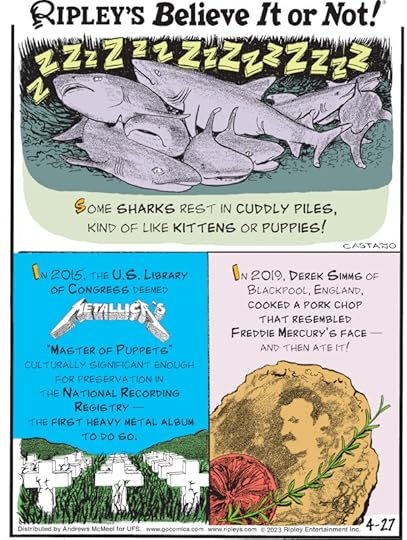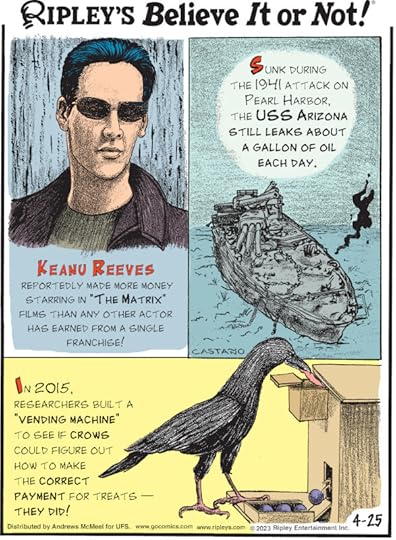Ripley Entertainment Inc.'s Blog, page 30
April 28, 2023
Coastal Sea Life Is Thriving on Trash Floating in the Pacific Ocean
Featured in Ripley's Believe It or Not!

Dozens of marine species are inhabiting garbage that is floating in the middle of the ocean. What makes this discovery even more unusual is that the sea life, including anemones, worms, and crustaceans, typically stay near coastal areas. A study about the phenomenon was recently published in Nature Ecology & Evolution.
Sea-ing is BelievingMarine ecologist Linsey Haram of the Smithsonian Environmental Research Center said that finding so many coastal species on a small sample was “shocking.” That is because many have believed the high seas is an area in which coastal species would never inhabit.
Researchers analyzed more than 100 pieces of debris from what is called the Great Pacific Garbage Patch, which is located between Hawaii and California. The trash pile was created by currents and the accumulation of floating debris. Believe It or Not!, scientists found coastal species present on 70 percent of the pieces of garbage!
This floating ocean garbage is home to a surprising amount of life from the coasts https://t.co/7EWK0AjzvL pic.twitter.com/QqBZFqj2Ii
— WCMU Public Radio (@WCMUNews) April 17, 2023
While coastal species have been known to hitch a ride on ships and floating debris, scientists were unaware that they could survive for a prolonged period in the middle of the ocean or create new populaces there. That’s because ocean and coastal areas differ when it comes to factors such as temperature, salinity, and nutrients.
Rethinking Coastal LifeThe 2011 tsunami in Japan upended scientific notions about coastal life’s survivability in a different environment. After the tsunami, items from the East Asian country appeared in areas like Hawaii several years later with coastal species intact.
With the assistance of the nonprofit group The Ocean Cleanup, Haram and her team collected a variety of items, including buckets, bottles, crates, and ropes. At the lab, they determined that most marine invertebrate specimens living on the garbage were from coastal areas. The trash was also home to sea life that commonly lives in the open ocean. The number and diversity of creatures was unexpected. Plus, some were procreating on their plastic homes, including a Japanese anemone.
Also notable is that coastal species and open-ocean sea life were cohabiting on the same piece of garbage. How they interact is unclear, but they likely challenge one another for space and food. Scientists also observed coastal anemones eating an ocean-dwelling purple snail.
According to Sabine Rech, a marine biologist from the Universidad Católica del Norte in Chile, it shows that coastal life surviving a long duration at sea is more than just a one-off event. “With the latest research, we see that it’s just something that is normal now, that is happening all the time,” she noted. “Coastal species are traveling on a regular basis, all the time, away from their habitat.”
The problem is that certain species may become invasive when traveling to new homes. The ability of coastal species to anchor themselves to man-made objects is revolutionary, fascinating, and “a bit scary,” said Rech, who has studied life on ocean garbage in the South Pacific. She and her team have not found the same diverse number of coastal creatures in the items they have analyzed from the South Pacific.
Ripley’s Aquariums and Marine ConservationHere at Ripley’s, we understand the importance of protecting the habitats of marine life. That’s why all of Ripley’s Aquariums are connected by Ripley’s Marine Science Research Center, a state-of-the-art quarantine, rescue, and research facility that supports Ripley’s conservation efforts and advancements in the sustainability of species. Alongside research and rescue efforts, Ripley’s Aquariums aims to educate our guests on how they can take action to protect the world around us.
The Aquariums also donate to SANCCOB, a registered nonprofit whose primary objective is to reverse the decline of seabird populations through the rescue, rehabilitation, and release of ill, injured, abandoned, or oiled seabirds — especially the endangered African penguin.
There is still so much left to explore in the ocean and its up to all of us to make sure they are thriving for generations to come.
By Noelle Talmon, contributor for Ripleys.com
EXPLORE THE ODD IN PERSON! Discover hundreds of strange and unusual artifacts and get hands-on with unbelievable interactives when you visit a Ripley’s Odditorium!Source: Coastal Sea Life Is Thriving on Trash Floating in the Pacific Ocean
CARTOON 04-28-2023
April 27, 2023
What We Can Learn From The “Telling the Bees” Tradition
Featured in Ripley's Believe It or Not!

If you’re a pet owner, this stat likely won’t surprise you. But if you don’t have a fur baby, you might want to take a seat before continuing. According to a recent study, most Americans talk to their pets. Fifty-five percent, to be exact. Moreover, 48 percent confess to having imparted a secret to their domestic animal that no one else knows. Talk about man’s (and woman’s) best friend! But a couple hundred years ago, carrying on conversations extended much further than housebound mammals.
In fact, bees ranked at the top of everyone’s list. When big pieces of news hit a family, whether involving a death or a wedding, the family’s honeybee colonies were among the first to know. Keep reading to learn more about this bizarre practice and the dangerous fate that awaited those who failed to confide in their residential hives.
Bees and Humans Go Together Like Honey and BreadCanines have been hanging out with human beings for a really long time. Archaeological evidence suggests they’ve been our companions for at least 30,000 years! That’s 20,000 more years than other domesticated animals like horses, sheep, and cattle.
As for honeybees, archaeologists believe humans have actively domesticated them for at least 9,000 years. Ancient pottery hailing from North Africa, the Near East, and Europe support this timeline, containing traces of beeswax. These finds illustrate how long humans and members of the Apidae family have collaborated.
With such a long history between humans and bees, it’s little wonder that superstitions surrounding beekeeping have popped up over the centuries. One of the most colorful examples remains the traditional practice of “telling the bees.”
The Intangible Magic of “Telling the Bees”When families go through life changing events like death or marriage today, insurance companies, Social Security, and the DMV rank at the top of the list for notifications. But two centuries ago, the family beehives were the first place many family members went. There, they notified the hives they maintained so that they could share in the mourning or celebration.

‘The Bee Friend’ by Hans Thoma. Via Wikimedia Commons.
Some historical accounts even mention leaving a piece of wedding cake or a funeral biscuit for the six-legged critters. Other traditions associated with “telling the bees” include covering the hives with black crepe and knocking once on each one before relaying the family’s news. Other regions of the country recommended singing this news to the little honey-makers, and still others suggested the information be delivered precisely at midnight.
Forgetting the Practice Could Lead to Dangerous ConsequencesThe practice of “ricking” also took place in some locations. This involved having the oldest son in a family move the hives to the right, symbolizing a change within the human home. Some people also pointed their hives toward the family residence. This proved especially popular when families prepared for a wake within their home.
Of course, this historical hubbub begs the question: What happened when families failed to relay important information to their bees? Some historical accounts point to odd happenings. For example, the Associated Press noted that in 1956 a bee swarm showed up at the funeral of an apiarist named John Zepka. According to the account, the bees hung out on the funeral tent’s ceiling and floral sprays without bothering anybody. And other reports speak of whole bee colonies getting sick and even dying when families failed to tell them about recent deaths.
The bottom line? People once assumed a shared sympathy between bees and humans and went to great lengths to honor it. In a time when the very existence of bees is threatened, some researchers believe it’s time to reforge the intimate relationship once enjoyed between humans and these hardworking insects. This hearkens back to a famed statement by Einstein that may be far more prescient than we once realized, “If the bee disappeared off the face of the Earth, [humans] would only have four years to live.”
By Engrid Barnett, contributor for Ripleys.com
EXPLORE THE ODD IN PERSON! Discover hundreds of strange and unusual artifacts and get hands-on with unbelievable interactives when you visit a Ripley’s Odditorium!Source: What We Can Learn From The “Telling the Bees” Tradition
CARTOON 04-27-2023
April 26, 2023
The Art Of Immortalizing Kim Kardashian
Featured in Ripley's Believe It or Not!

Using both traditional techniques and new technologies, Ripley’s Believe It or Not! has officially teamed up with Kim Kardashian once again to create a wax figure of her famous 2022 Met Gala moment.

To make the most lifelike figure possible, Ripley’s had the real Kim pose inside two photogrammetry rigs. These high-tech contraptions were used to create detailed 3D scans by taking photos of Kim from almost every angle simultaneously with dozens of DSLR cameras — 200 for the full-body shots and 73 for her face!

The photogrammetry rigs used to capture the 3D scans of Kim’s body. That’s a lot of cameras!
While advanced technology has its benefits, Ripley’s Art Department also relied on old-school, tried-and-true methods to capture Kim’s exact likeness. Ensuring the utmost accuracy, the team took more than 100 measurements of her head and face alone! Kim also sat through the uncomfortable and time-consuming process of having a cast made of her face out of silicone and plaster.
When jokingly asked whether the molding process felt like a spa day, a silicone-covered Kim gave a resounding thumbs-down.

Kim being lathered in silicone and plaster for the molding of her face.
Molds of Kim’s body are currently in the works and will soon be brought to life with details added by Ripley’s artists, from her hair (each strand inserted individually by hand) to her makeup, manicure, and, of course, the dress.
The Ripley’s Art Department will craft yet another replica of Marilyn Monroe’s “Happy Birthday” dress, hand-sewing on nearly 2,500 crystals — just like the original.

The mold of Kim’s face – look at that detail!
Only At Ripley’s Believe It or Not!The original dress, famously worn by Marilyn Monroe when she sang “Happy Birthday” to President John F. Kennedy and lent to Kim for her walk on the red carpet, is currently on display at Ripley’s Believe It or Not! Hollywood. There, guests can get an up-close view of this stunning garment.

Marilyn Monroe at President Kennedy’s 45th birthday celebration on May 19, 1962. Credit: Cecil Stoughton. White House Photographs. John F. Kennedy Presidential Library and Museum, Boston.
Visitors also can get a behind-the-scenes look at Kim’s Met Gala journey, plus historic pieces of Marilyn Monroe and John F. Kennedy memorabilia.
Upon completion, Kim Kardashian’s wax figure will go on display at select Ripley’s Believe It or Not! and Louis Tussaud’s Waxworks locations around the world.
EXPLORE THE ODD IN PERSON! Discover hundreds of strange and unusual artifacts and get hands-on with unbelievable interactives when you visit a Ripley’s Odditorium!CARTOON 04-26-2023
April 25, 2023
SpaceX: The Company Transforming The Night Sky
Featured in Ripley's Believe It or Not!

Elon Musk’s brainchild SpaceX has kept the skies busy in recent years. Evidence of the company’s activity is most visible at night. But events like the recent Starship launch and explosion have offered plenty of daytime spectacle, too. Starship flew for four minutes in its first orbital test before the automated systems kicked in, initiating a jaw-dropping explosion near Port Isabel, Texas. Debris and dust scattered for miles.
One local who lives six miles north of SpaceX’s Starbase in Boca Chica described the messy, noisy aftermath as “truly terrifying.” Others reported a “mini earthquake,” broken windows, and particles raining down. This isn’t the first time SpaceX has given people something to stare at. Its famed Starlink satellite trains crawl like illuminated centipedes across the night sky.
And a recent fuel dump by Space X resulted in a breathtaking sky spiral against the backdrop of Alaska’s aurora borealis.
A One-of-a-Kind Sight Over Alaska’s SkiesIn the wee hours of Saturday, April 15th, aurora borealis fans got an eyeful over the frosty skies of Alaska. Overlaying the swirling, dancing green lights of the northern lights, spectators saw a powder-blue-hued spiral. Reminiscent of a galaxy, the display remained visible for mere minutes. But thanks to time-lapse footage captured by the Geophysical Institute’s all-sky camera, the event was permanently preserved. Not surprisingly, the images soon went viral.
Hands-down gotta be one of the coolest sights — @SpaceX falcon9 and Aurora in the skies over our cabin in Fairbanks, Alaska this morning. pic.twitter.com/jhno8zK6TW
— Kris10 (@53chevygirl) April 15, 2023
How did this strange spiral end up in the sky, and what did SpaceX have to do with it? We must travel thousands of miles south to California to track down the answer. At Vandenberg Space Force Base, a SpaceX rocket launched Friday night, carrying a payload of 25 satellites. Along the way, the rocket ejected excess fuel. This common practice led to something magical as the spent fuel reached higher altitudes.
Don Hampton of the University of Alaska Fairbanks explains, “When [rockets] do that at high altitudes, that fuel turns into ice. And if it happens to be in the sunlight, when you’re in the darkness on the ground, you can see it as a sort of big cloud, and sometimes it’s swirly.” Of course, what happened over the skies of Alaska at the end of April was clearly a next-level swirl. Juxtaposed against the aurora borealis, it made for unforgettable images.
Northern Lights Photographers Capture the ImageBesides the Geophysical Institute’s pics, some amateur photographers captured the minutes-long event. Many posted their photographs to the internet, ramping up the swirl frenzy. One of those lucky enough to be positioned for picture taking was Todd Salat, a professional photographer.
No, it was not aliens.
The blue spiral on Saturday across the northern lights in Alaska came from SpaceX’s Falcon 9 rocket launch in California, and the reflection of the excess fuel it released into the atmosphere had probably created the dizzying pattern.https://t.co/dfJFrLnszA pic.twitter.com/UTQ6XixBHa
— The New York Times (@nytimes) April 20, 2023
In an email, he later explained, “Trust me, at first, I was totally bewildered … I thoroughly enjoyed the mysterious feeling of the unknown.” The sight proved especially spectacular because of two factors: 1) the time of the fuel dump and 2) the fact it was a polar launch.
That said, this isn’t the first time that spirals have graced the sky.
In January, Hawaii’s Big Island got its own show. That’s when a camera located on the summit of Mauna Kea snapped images of another mysterious swirl. The capture took place outside of the National Astronomical Observatory. This time, the culprit was the launch of a military GPS satellite from a SpaceX rocket in Florida. But nothing beats the social media storm created by the Alaska event because of the stunning background against which it unfolded.
By Engrid Barnett, contributor for Ripleys.com
EXPLORE THE ODD IN PERSON! Discover hundreds of strange and unusual artifacts and get hands-on with unbelievable interactives when you visit a Ripley’s Odditorium!CARTOON 04-25-2023
April 24, 2023
CARTOON 04-24-2023
April 23, 2023
CARTOON 04-23-2023
Ripley Entertainment Inc.'s Blog
- Ripley Entertainment Inc.'s profile
- 52 followers









